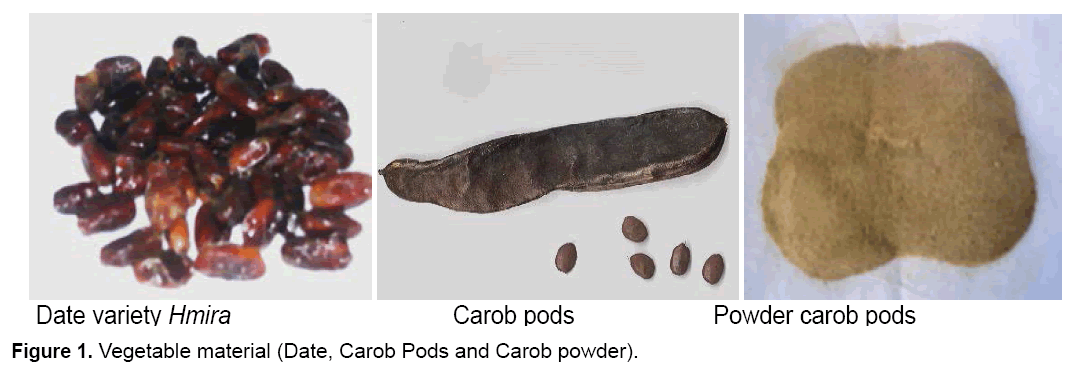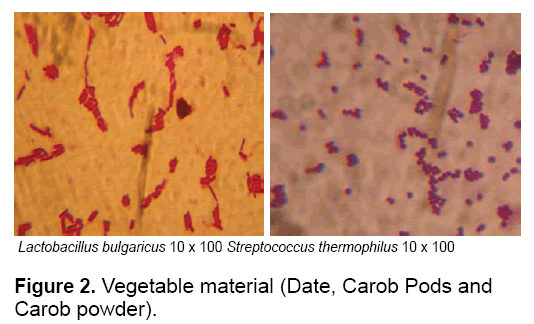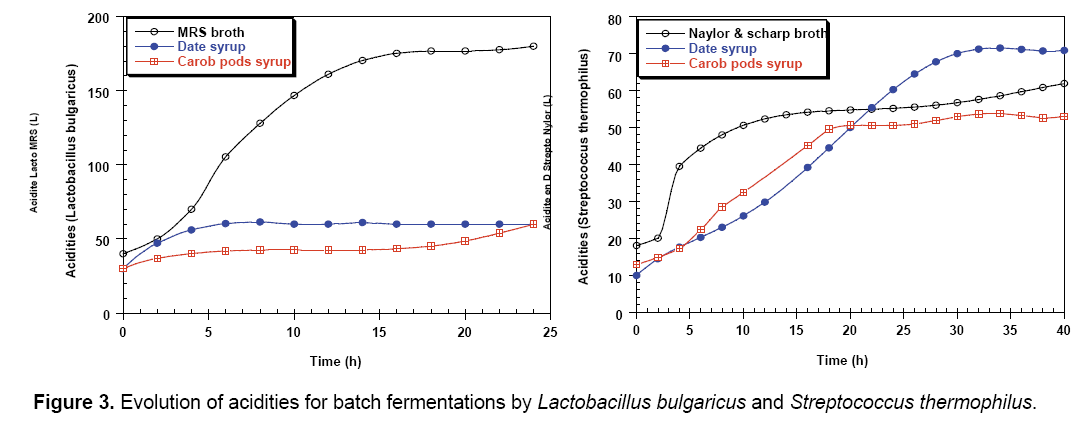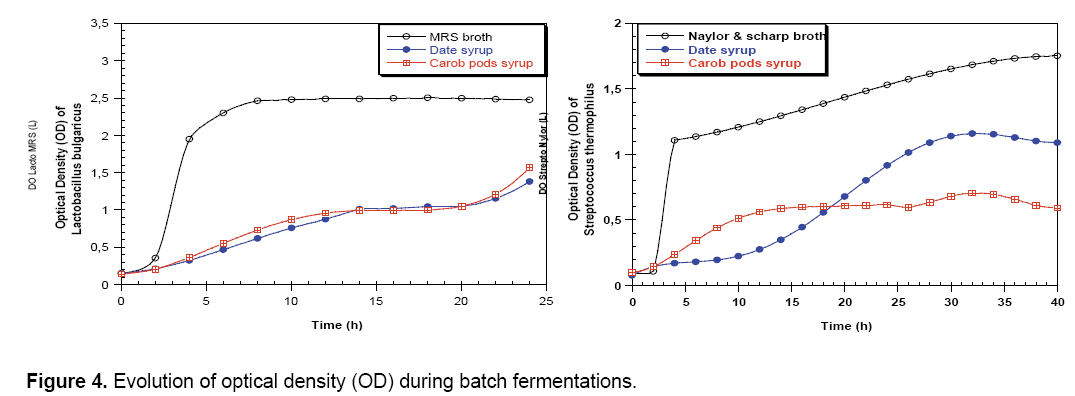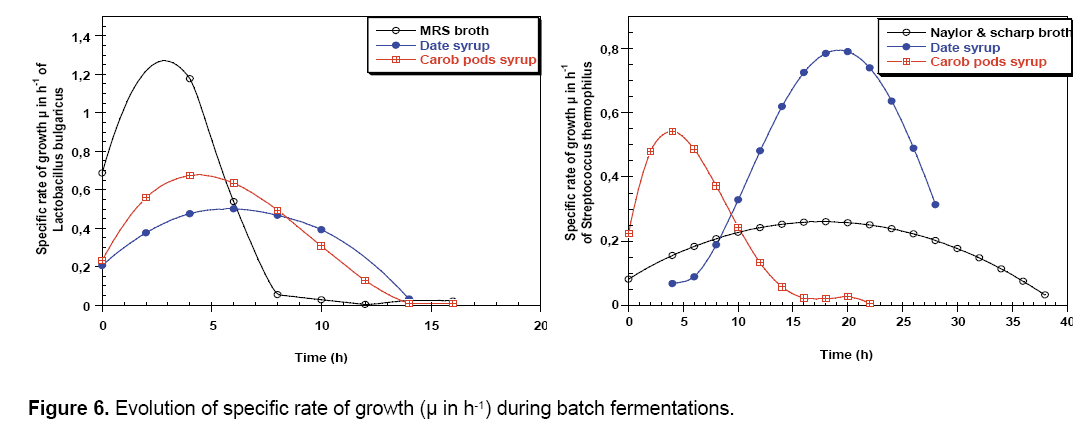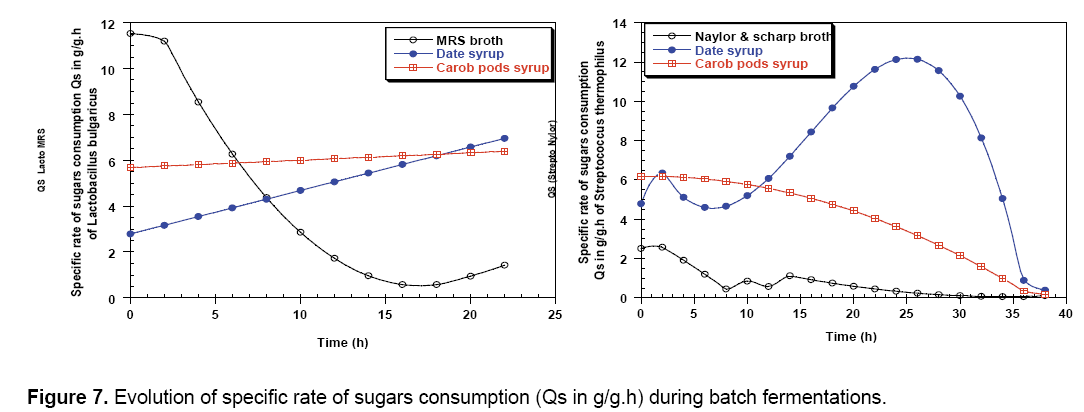Kinetic Study of The Growth of Lactobacillus bulgaricus and Streptococcus thermophilus from Date Syrup Variety Hmira and Carob Pods Syrup
Ouis Nawel, Hariri Ahmed
1 Laboratory of Chemisty, Department of Chemistry, Faculty of Sciences, University of Oran Es- Sénia, BP 1524 El M’naouer, Oran 31100, Algeria;
2Bioconversion Laboratory, Microbiology Engineering and Health Safety, Department of Biology, Faculty of Science the Nature and Life, University of Mascara. BP.763, Sidi Said, Mascara, 29000, Algeria
Received date: January 29, 2016 Accepted date: February 26, 2016 Published date: March 06, 2016
Citation: Nawel O, Ahmed H, Kinetic Study of The Growth of Lactobacillus bulgaricus and Streptococcus thermophilus from Date Syrup Variety Hmira and Carob Pods Syrup. Electronic J Biol, 12:1
Abstract
The objective of our study was to use of Lactobacillus bulgaricus and Streptococcus thermophilus for kinetics study of lactic acid production from Carob pods syrup and Date syrup. The biologic material used is cultures of Streptococcus thermophilus and Lactobacillus bulgaricus. The Lactic Acid Bacteria was isolated and identified by biochemical biochemical tests. Biochemical analysis of date and carob syrups was taken. Three cultures fermentations of Lactobacillus bulgaricus were carried out in a 2 L jar fermenter (Applikon Biocontroller ADI1030) in MRS broth, in date syrup at concentration 20% and in carob pods syrup medium at concentration 20%. The same cultures fermentations were made by Streptococcus thermophilus in Naylor and Sharpe medium, date syrup and carob pods syrup. The different physicochemical and biochemical analyzes show the richness of date and carob pods syrups in nutritional elements that makes them favorable to the lactic acid fermentations. The Lactobacillus bulgaricus and Streptococcus thermophilus growth’s for the fermentations are characterized by a short duration of the latency phase which indicates that the inoculated cells were in full exponential phase and the perfect adaptation of strains to the different medium used. Kinetics study of growth of Lactobacillus bulgaricus and Streptococcus thermophilus in Carob syrup and Date syrup showed that these medium are favourable to the lactic acid fermentations.
Keywords
Carob; Date; Fermentation; Lactobacillus bulgaricus; Streptococcus thermophilus.
Introduction
Carob (Ceratonia siliqua L.), which has been widely grown in the Mediterranean region, belongs to the Caesalpinaceae subfamily of the family Leguminoseae [1,2]. Carob tree is used in reforestation of arid and degraded areas and also as for ornamental purposes [3-5]. However, in recent years, it has been used in the food industry as bioresource and biomass substrate and thus has attracted the attention of producers because of increasing market value. The pulp and the seeds have some interesting properties and are often used in food and pharmacological industry [1,6]. The pulp content in the pod ranges from 73-95 % [7]. The pod of the carob has a high energy value 17.5 kJ/g D.M. [5,8] and has long been used as a feed for livestock and human consumption, including sweets, biscuits, and traditional carob concentrate called “pekmez” [9,10]. When the fruits are ripe enough, they have 91-92% total dry matter and 62-67% total soluble solids, which consist of 34-42% sucrose, 10-12% fructose, and 7-10% glucose [9]. Carob pods are also characterized by high sugar content 500 g/kg [1,6,11]. Moreover, carob pods contain appreciable amount of fiber (4.2-39.8%), depending on the type of the extracted fiber [7,12]. The carob is rich in calcium, antioxidants and polysaccharides. Carob also contains phenolic compounds from 2-20% D.M. [6,13]. These phenolic compounds present opportunities chemo-preventive interesting against certain cancers, especially those of the gastrointestinal tract. These phenolic compounds are mainly composed of gallic acid, syringic, p-coumaric, m-coumaric, benzoic acid and hydroxytyrosol [14]. Carob pulp is a good source of polyphenols (mainly tannins 16-20%) [5,13], and protein (2.7-7.6 %) but it is poor in lipid (0.4-0.8%). The pod fiber content plays a role in hypocholesterolemic and hypoglycemic regulation, whereas phenolic compounds can be used as antioxidant additive [15]. Moreover, the locust bean gum (additive E 410) extracted from the endosperm of seeds is used as stabilizer and thickening agents in food industry [16]. The locust bean gum is also applied in pharmaceutical industry as drug delivery [17]. Chemical composition of carob had been studied extensively for different countries of the Mediterranean area. It had been observed that this composition is depending not only on technological factors such as the extraction and analytical methodologies, but also on the genotype of the plant, the geographical origin, the climate conditions and the harvesting and storage procedures [1,5,13,18-20]. However, in spite of the great interest to carob and their use in different applications, few studies are available on Algerian carob. The obtained carob extract has been utilized for production of value added products, especially by fermentation as suggested [21,22]. Lactic acid can be one of these value added products due to its current and future potentials.
In Algeria, the production of dates is estimated to 473 000 tons which 60 000 to 75 000 tons is minus appreciated on the market, constituted of common of dates and offal’s of Deglet-Nour [23]. Dates are the subject of an important marketing activity, in particular the famous Deglet-Nour variety. This one holds the monopoly in national and international markets. It profits even from certain marketing (presentation, packing). In parallel the other varieties known as common are less appreciated, less marketed and less competitive; they represent approximately 30% of the national production [24,25]. Subsequently, they provide a very high energy and nutriments: sugars, vitamins and minerals. The waste and un-wanted materials usually issued from fermentation one being used to produce, protein and carbohydrate. The valorization of common dates by the biotechnical processes represents a solution of choice insofar as it allows producing some substances to high added value [26]. The dates have already been the subject of many tests in other countries. They are exploited as fermentation substrate for various metabolites production such as citric acid, ethanol and even biomass production (yeast bread) [27]. The objective of our study was to use of Lactobacillus bulgaricus and Streptococcus thermophilus for kinetics study of lactic acid production from Carob pods syrup and Date syrup.
2. Material and Methods
2.1 Vegetable material
The carob (Ceratonia siliqua L.) used in current experiments was harvested in the region of ELBORDJ (Mascara, Algeria) and the date (Phoenix dactylifera L.) was a variety half soft, known as Hmira badly exploited, cultivated in the area of Adrar (South-East of Algeria). The choice of these varieties is justified by its availability and important nutritive value, especially the one of reducing fermentable sugars such as glucose and fructose. Its morphological characteristics are given in Table 1 and Figure 1.
| Carob characteristics | Average | Date characteristics | Average |
|---|---|---|---|
| Pod length (cm) | 20.4 ± 1.314 | Weight of date (g) | 8.5 ± 0.76 |
| Pod width(cm) | 2.46 ± 0.047 | Weight of pulp (g) | 7.16 ± 0.93 |
| Pod thickness (cm) | 0.76 ± 0.094 | Weight of the stone (seed) (g) | 1.27 ± 0.18 |
| Pod weight (g) | 26.83 ± 0.3299 | Length of date (cm) | 3.33 ± 0.16 |
| Pod volume (cm3) | 28.53 ± 3.23 | Width of date (cm) | 1.88 ± 0.41 |
| Specific gravity | 0.906 ± 0.046 | Length of the stone (seed) (cm) | 2.11 ± 0.19 |
| Size index | 9.22 ± 0.05887 | Width of the stone (seed) (cm) | 0.67 ± 0.34 |
| No. seeds/pod | 13.33 ± 1.2472 | ||
| Seeds weight | 2.366 ± 0.20548 | ||
| % seeds/pod | 8.82 ± 0.8141 |
Table 1: Mean values of the physical measurements of carob pods and Date variety Hmira.
2.2 Biologic material
The biologic material used is cultures of Streptococcus thermophilus and Lactobacillus bulgaricus, derived from Orolait of Mascara (Algeria). The mixed culture is homofermentative (homolactic) which means that more than 90% of metabolites are produced by the lactic fermentation.
2.3. Lactic acid bacteria isolation, biochemical characterization and presumptive identification
Five 10-fold dilutions of the mixed culture (Streptococcus thermophilus and Lactobacillus bulgaricus) were then prepared and these were inoculated on plates of MRS agar acidified with glacial acetic acid to pH 5.4, MRS to pH 6.5, M17 medium to pH 7.1 and incubated anaerobically at 45°C during 24-48 hours. Colonies with typical characteristics were randomly selected from plates and tested for Gram stain, cell morphology, catalase and oxidase reaction before further sugar fermentation and characterization tests [28,29]. The short term conservation of the pure isolates was done on solid media [30]. After growth at optimal temperature, the culture was maintained at 4°C and cultures were renewed every month. The long-term conservation of the purified isolates was carried out in MRS broth containing glycerol (Merck, Darmstadt, Germany) (v/v 70/30) and were maintained as frozen stocks at -80°C [31]. Strains were characterized according to the methods and criteria of Buchanan et al. [32] and Klein [33] as follow: They were checked for gas production from glucose in MRS broth containing Durham tubes [34]. Growth at different temperatures was observed in MRS and M17 broth after incubation for 5 days at 15, 37, 45°C then 12 days at 5 and 10°C [30]. The ability to grow at pH 3.9 and 9.6 (for MRS broth) and at pH 9.6 (for M17 broth) were tested [35]. The tolerance to NaCl was studied by growth in MRS and M17 broth containing NaCl at concentrations 2%, 4% and 6.5% as described by Stiles and Holzapfel [36]. Arginine dihydrolase was determined in MRS broth supplemented with 0.3% arginine, which was incubated for 3 days, followed by NH3 detection by addition of Nessler’s reagent. Hydrolysis of esculin and the effect of bile salts were observed on bile esculin agar. Heat resistance was determinated in MRS and M17 broths at 60 and 65°C for 30 min [37]. Citrate utilization was studied on the media of Kempler and Mc Kay [38]. Production of dextran was recorded on MSE agar [39] and the production of acetoine from glucose was determined by using the Voges-Proskauer test [40].
2.4 Extraction of date and carob pods syrup
The dates were washed in order to eliminate sand and dust, and then cut into the small particles (1-3 cm) to increase the surface of diffusion. The pieces of dates were mixed with distilled water at a concentration 20% (200 g of dates in 1 L of water) and left during 2 h at 90°C. After filtration the syrup obtained was centrifuged at 5000 rpm during 30 min to separate the cellulose debris. The collected supernatant was used as culture medium. The syrup is sterilized during 20 minutes at 120°C under a maximum pressure of 2 bars has been applied. The syrup collected is characterized by a honey colour, a pleasant odour and very sweetened. Carob pods were chopped into small particles (1-3 cm). One liter of hot water at 85-90°C was added to 200 g of carob pods (20%), homogenized and through a cloth. The syrup obtained was centrifuged at 15.000 rpm for 10 min to separate the cellulose debris. The collected supernatant was used as culture medium. The syrup is fixed in a pH 6 and sterilized during 20 min at 120°C. The extraction parameters were obtained from method advocated by Turhan et al. [41].
2.5 Biochemical analysis of date and carob pods syrups
pH and conductivity are measured using a pH meter and density was determined by density meter. Viscosity is measured using the drop bile viscometer (HAAKE). The optical density is measured by spectrophotometer at 420 nm of filtered syrup [42]. Concentration of lactic acid was determined by acidity titration with NaOH 0.1 N. Total nitrogen and protein content was determined by the method of Kjeldahl digestion and distillation apparatus [43,44]. Total and reducing sugars were determined calorimetrically at 480 nm by Dubois method [45]. Standards were prepared with glucose solutions at different concentrations. The ash content was determined according to the AOAC official method 972.15 by incineration one gram of syrup at a temperature of 600°C during 3 h [46] and the mineral salts was determined according to the methods advocated by Hamon et al. [43]. Moisture and dry matter were determined by drying 10 mL of syrup at 105°C during 18 h. The content of vitamin C is determined according to the methods advocated by Hoffman [47]. For determination of amino acid content, 5 mL of date syrup was mixed with 1 mL of ninhydrin reagent then heated at 80-160 °C during 4 minutes. The optical density of control and the sample were measured at 570 nm. In the control, we replace the syrup with distilled water. At the same time we realize a calibration with different concentrations of glycine. For determination of tannin content, 6 mL of butanoic acid and 1 mL of date syrup was added with stirring 0.2 mL of reactive iron and then put the mixture in boiling water bath for 50 minutes. The absorbance of the control and the sample are measured at 550 nm. In the control, we replace the syrup with distilled water. At the same time, we make the standard curve with different concentrations of tannic acid. Pectin was determined by mixed 10 g of date syrup with stirring 10 mL of 10% NaOH and then after standing for 5 minutes introducing 4-8 mL of HCl 5 N followed by heating for 5 min. After filtration, the capsule is placed in an oven at 105°C until a constant weight (P1). After drying, it is introduced in a muffle furnace at 700°C; we conducted a further weighed (P2). The percentage of pectin is given by the following formula:
Pectin % = (P1- P2) / M.10
Where P1: The sample mass after drying, P2: The sample mass after calcinations, M: The mass of the test.
2.6 Fermentation conditions and methods
All experiments were carried out in a 2 L jar fermenter (Applikon Biocontroller ADI1030) with an initial volume of 1.5 L at 45°C. The agitation speed was set at 300 rpm to insure complete mixing of the fermentation medium. The inocula were incubated at 45°C for 12 h at 300 rpm before their transfer to the fermenter in a 10%. The culture pH was maintained at 6.5 by automatic addition of 25% (w/w) NH4OH solution using a computer coupled peristaltic pump during the 24 hours of fermentation. The samples were withdrawn at desired intervals and frozen for further analysis. Three cultures of Lactobacillus bulgaricus were used: in MRS broth, in date syrup at concentration 20% and in carob pods syrup medium at concentration 20%. The MRS medium used in growth and inoculum preparations contained the following components (in g/L): 10 Soya peptone, 10 beef extract, 5 yeast extract, 2K2HPO4, 5NaCH3CO2, 3H2O, 2 triammonium citrate, 0.2 MgSO4, 7H2O, 0.05 MnSO4, H2O, 20 glucose and 1 mL Tween 80. The same cultures are made by Streptococcus thermophilus in Naylor and Sharpe medium, date syrup and carob pods syrup. The Nylor and Sharp medium (Yeast Glucose Lemco Broth) used in growth contained the following components (in g/L): 10 peptone, 10 beef extract, 3 yeast extract, 5 sodium chloral and 5 glucose. The evolution of the biomass, the residual sugars amount and the lactic acid production are followed in regular time intervals. The various analyses carried out allow the following time evolution of the component concentrations present in the culture medium. From these raw data it is possible to calculate the fermentation kinetic parameters in the batch culture by the calculation of the specific rate of growth μ in h-1, of sugars consumption Qs in g.g-1.h-1 and of lactic acids production Ql.a in g.g-1.h-1.

The maximal specific growth rate (μmax) was determined from the slopes of the plotted linear curve: Ln X/X0=f (t).
3. Results and Discussion
3.1 Isolation and identification of Streptococcus thermophilus and Lactobacillus bulgaricus
Colonies on MRS medium are whitish, smooth and small. These strains are Gram+ (purple) and bacillary form. The development on M17 gives white colonies, round, opaque, with smooth boundary. These strains are present in the form of cocci in pairs or chains Gram +. Results are shown in the Figure 2 and Table 2.
| Characteristics | Lactobacillus bulgaricus | Streptococcus thermophilus |
|---|---|---|
| Gram | + | + |
| Catalase | - | - |
| Growth at 15°C | - | - |
| Growth at 37°C | + | + |
| Growth at 45°C | ++ | ++ |
| Growth at pH 9.6 | / | - |
| Growth at pH 3.4 | + | / |
| Growth at bile salts | / | - |
| Growth at 2%NaCl | + | + |
| Growth at 4%NaCl | + | + |
| Growth at 6.5%NaCl | - | - |
| Resistance at 60°C | + | + |
| Resistance at 65°C | + | / |
| Growth on milk blue Sherman | / | - |
| Fermentative type | homo | homo |
| Esculin hydrolysis | + | - |
| ADH (Arginindihydrolase) | - | + |
| VP | - | - |
| Maltose | + | - |
| Levulose | + | + |
| Glucose | + | + |
| Galactose | + | + |
| Fructose | + | + |
| Mannose | - | + |
| Sorbitol | - | - |
| Saccharose | - | + |
| Xylose | - | - |
| Lactose | + | + |
| Arabinose | - | - |
| Haemolyse | / | γ |
Table 2: Physiological and biochemical tests results of Lactobacillus bulgaricus and Streptococcus thermophilus.(+): positive response, (-): negativereaction
3.2. Biochemical composition of carob pods syrup and date syrup
The carob pods syrup has a 94.44% of moisture and the date syrup which has been the subject of our work has similar water content 92.4%, we agree that a product with high water content facilitates lactic acid bacteria proliferation and helps for a better substrate-enzyme contact since free water is the nutriments carrier. Results are shown in the Table 3.
| Constituents | Date Syrup | Carob pods Syrup |
|---|---|---|
| Moisture (%) | 92.4 | 94.44 |
| Dry Matter (%) | 7.60 | 5.56 |
| pH | 4.62 | 5.25 |
| Acidities (m.eq%) | 26 | 30 |
| Density (Kg/m3) | 1.067 | 2.543 |
| Viscosity (mPa.s) | 2.01 | / |
| Total sugars in g/L | 40.66 | 22 |
| Reducing sugars in g/L | 27.30 | 30.69 |
| Sucrose in g/L | 4.16 | / |
| Proteins in % of M.F | 0.081 | 0.25 |
| Amino Acid (mol/L) | 0.018 | / |
| Vitamin C (mg/L) | 0.19 | / |
| Tannin % | 1.5 | / |
| Pectin % | 7.5 | / |
| Copper in mg/100mLof M.F | 0.17 | / |
| Ashes in % of M.F | 0.8 | 0.2 |
| Potassium in mg/100mL of M.F | 15 | 18.5 |
| Phosphor in mg/100mLof M.F | 28 | / |
| Sodium mg/100mLof M.F | 1.9 | 1.9 |
| Calcium in mg/100mLof M.F | 122 | 69 |
| Zinc in mg/100mLof M.F | 0.19 | / |
| Magnesium in mg/100mLof M.F | 0.12 | / |
| Manganese in mg/100mLof M.F | 0.19 | / |
Note: /: No Measured, DS: Date Syrup, CS: Carob Syrup, HE: Hot extraction, 20%: Concentration
Table 3: Biochemical composition of date syrup and carob pods syrup
Date syrup will be very rich of reducing sugars 27.3 g/L and 30.69 g/L for carob syrup. Reducing sugars are a carbon source that can satisfy the lactic acid bacteria requirements. The protein fraction and amino acids are considerable; therefore it can serve as a nitrogen source. An ash content of 0.8% for date and 0.2% for carob indicates its richness of minerals including potassium, sodium, phosphor, zinc, Magnesium, Manganese and calcium. The date syrup has an acidic pH 4.62, acidities 26 and carob syrup has pH 5.25 which indicates its good nutritional quality (no bacterium contamination) suitable for the proper development of lactic acid bacteria. The different physicochemical and biochemical analyzes show the richness of date and carob pods syrups in nutritional elements that makes them favorable to the lactic acid fermentation.
3.3 Lactic acid fermentations of Carob pods and Date Syrups
This study was designed to evaluate the potential of date and carob pods syrups for lactic acid production by Lactobacillus bulgaricus and Streptococcus thermophilus. Results are shown in the Table 4.
| Parameters | Lactobacillus bulgaricus | Streptococcus thermophilus | ||||
|---|---|---|---|---|---|---|
| MRS broth | Date syrup | Carob pods syrup | Naylor & Sharpe broth | Date syrup | Carob pods syrup | |
| Optical Density i. | 0.15 | 0.15 | 0.14 | 0.092 | 0.077 | 0.098 |
| Optical Density f. | 2.5 | 1.38 | 1.56 | 1.75 | 1.16 | 0.7 |
| Sugars i. (g/L) | 19.5 | 27.27 | 30.79 | 4.96 | 27.08 | 30.54 |
| Sugars f. (g/L) | 4.2 | 9.73 | 10.43 | 2.18 | 4.63 | 14.71 |
| Sugarsconsumption (g/L) | 15.3 | 17.54 | 20.36 | 2.78 | 22.45 | 15.83 |
| Aciditiesi. | 40 | 30 | 30 | 18 | 9.9 | 12.86 |
| Aciditiesf. | 180 | 60 | 60 | 61.85 | 71.5 | 53.75 |
| µmax (h-1) | 1.2 | 0.5 | 0.67 | 0.25 | 0.8 | 0.54 |
| Qs max (g/g.h) | 11.53 | 6.96 | 6.39 | 2.5 | 12.14 | 6.19 |
| QL.a max (g/g.h) | 11.81 | 5.7 | 2.48 | 2.7 | 3.54 | 3.1 |
| Yx/s (g/g) | 0.07 | 0.13 | 1.47 | 0.21 | 0.12 | 0.08 |
| YL.a/s (g/g) | 1.36 | 1.13 | 6.24 | 0.53 | 0.44 | 0.42 |
Table 4: Kinetic parameters of Lactobacillus bulgaricus and Streptococcus thermophilus fermentations.i: Initial, f: Final, L.A: Lactic acid, Y: Yield.
The production curve of acidities in MRS broth by Lactobacillus bulgaricus begins with an initial acidity of 40 to achieve 180 after 25 h of fermentation. In parallel, the production of acidities in Date and Carob pods syrups by Lactobacillus bulgaricus begins with an initial acidity of 30 to achieve 60 in the end of fermentations. For Streptococcus thermophilus fermentations, the production of acidities in Naylor and Sharpe broth, Date syrup and Carob pods syrup begins respectively with an initial acidity of 18, 9.9 and 12.86 and evolves gradually to achieve respectively 61.85, 71.5 and 53.75 in the end of fermentations. The results clearly indicated that the highest amount of lactic acid was obtained with the fermentation of Date syrup by Streptococcus thermophilus compared to Naylor and Sharpe broth and Carob pods syrup. Results are shown in the Figure 3.
According to the obtained results, it is observed that the Lactobacillus bulgaricus and Streptococcus thermophilus growth’s for the fermentations are characterized by a short duration of the latency phase which indicates that the inoculated cells were in full exponential phase and the perfect adaptation of strains to the different medium used. Results are shown in the Figure 4.
On the other hand, the biomass evolution of Lactobacillus curvatus in the MRS broth starts with an initial concentration (OD=0.15) and after 25 h of fermentation it reaches a maximum value OD=2.5. In the fermentation of Date and Carob pods syrups, one we observe a similar initial concentration of biomass respectively 0.15 and 0.14 and in the end of fermentation optical density reaches a maximum value 1.38 for Date syrup fermentation and 1.56 for Carob fermentation.
The biomass evolution of Streptococcus thermophilus in the Naylor and Sharpe broth, Date syrup and Carob pods syrup begins respectively with an initial optical density of 0.092, 0.077 and 0.098 and evolves gradually to achieve respectively after 40h of fermentation to a maximum value respectively OD=1.75, 1.16 and 0.7.
However, decreasing of sugar rates is very faster in the MRS broth, Date syrup and Carob pods syrup.
Where the Lactobacillus bulgaricus consumes about major quantity of initial total sugars, during 25h of fermentation from an initial quantity respectively of 19.5, 27.27 and 30.79 g/L of sugars, it remains 4.2, 9.73 and 10.43 g/L which implies an amount of 15.3, 17.54 and 20.36 g/L. In parallel, 22.45 g/L from Date syrup as the quantity of sugar consumed by Streptococcus thermophilus. Results are shown in the Figure 5 and Table 4.
3.4. The kinetic parameters of fermentations: The specific rate of Lactobacillus bulgaricus growth (μ) in the MRS broth starts at 0.7 h-1 and reaches its maximum value 1.2 h-1 after 3 hours of fermentation, then it decreases down to 0 h-1 after 12 hours of culture. For the Date syrup fermentation, μ starts with an initial value of 0.2 h-1 increasing to 0.5 h-1 after 6 hours of fermentation. In the Carob pods syrup fermentation, the initial μ is 0.2 h-1 and increases to 0.67 h-1 after 4 hours of fermentation (Figure 6). This means that the fast increase in the bacterial mass during fermentation is due to the substrate consumption which is very important during this phase. We notice a progressive reduction of the bacteria growth rate which can be due to bacterial lysis.
The maximal sugar consumption specific rate (Qs max) is of the order of 11.53 g/g.h for the MRS broth cultures and decrease down to 6.96 and 6.39 g/g.h for the Date syrup and Carob pods syrup fermentations. The maximal (QL.a.max) lactic acid production specific rate is of the order of 11.81 g/g.h for the MRS broth. However it decreases considerably down to 5.7 and 2.48 g/g.h in the Date and Carob pods syrups cultures (Figures 7 and 8).
For the Carob pods syrup fermentation, the yield of sugar conversion into biomass is 1.47 g/g and 6.24 g/g into lactic acid. It seems that the majority of the sugar is used for the cellular maintenance and reproduction and the remainder for the lactic acid production.
Overall, when the Naylor and Sharpe broth fermentation medium was compared with Date and Carob pods syrups, in terms of lactic acid produced, maximum specific rate of growth of Streptococcus thermophilus (μmax), maximum consumption specific rate (Qs max), maximum lactic acid production specific rate (QL.A max), yield of lactic acid production (YL.A/s), there were significant differences. Fermentation with Date syrup resulted in significantly higher lactic acid productivity compared to Naylor and Sharpe broth and Carob pods syrup. Results are shown in the Figures 8 and Table 4.
4. Conclusion
The bioconversion of agricultural by- products mainly the ones rich in fermentable sugars has an economic and strategic interest. The main aim of this study was to use of Lactobacillus bulgaricus and Streptococcus thermophilus for kinetics fermentation of the Carob pods syrup and the Date syrup. By its biochemical composition, the Carob syrup and Date syrup are very rich in carbohydrates and nutritional elements. Which make it a substrate of choice for the development of high value added products? Kinetics study of growth of Lactobacillus bulgaricus and Streptococcus thermophilus in Carob syrup and Date syrup showed that these medium are favourable to the lactic acid fermentations.
5. Competing Interests
Authors have declared that no competing interests exist.
References
- Battle I, Tous J. (1997).Carob Tree(CeratoniasiliquaL.).(1stedn.), Biodiversity International: research for development in agricultural and tree biodiversity, Rome,Italy.
- Yousif AK, Alghzawi HM. (2000). Processing and characterization of carob powder. Food Chem.69: 283-287.
- Winer N. (1980). The potential of the carob (CeratoniasiliquaL.). Int tree crop J.1: 15-26.
- Girolamo R, Laura D. (2002). Evaluation and preservation of genetic resources of carob (Ceratoniasiliqua L.) in southern of Italy for pharmaceutical use. Breeding Res Aromatic Med Plant.9: 367-372.
- Biner B, Gubbuk H, Karhan M, Aksu M, Pekmezci M. (2007). Sugar profiles of the pods of cultivated and wild types of carob bean (CeratoniasiliquaL.) in Turkey. Food Chem.100: 1453-1455.
- Markis DP, Kefalas P. (2004). Carob pods (CeratoniasiliquaL.) as a source of polyphenolicantioxydants. Food TechnolBiotechnol.42: 105-108.
- Shawakfeh K, Ereifej KI. (2005). Pod Characteristics of two CeratoniasiliquaL. Varieties from Jordan. Ital J Food Sci.17: 187-194.
- Avallone R, Plessi M, Baraldi M, Monzani A. (1997). Determination of Chemical Composition of Carob (Ceratoniasiliqua): Protein, Fat, Carbohydrates, and Tannins. Journal of Food Composition and Analysis.10: 166-172.
- Karkacier M, Artik N. (1995). Physical properties, chemical composition and extraction conditions of carob (CeratoniasiliquaL.).Gida.20: 131-136.
- Dakia P, Wathelet B, Paquot M. (2007). Isolation and chemical evaluation of carob (CeratoniasiliquaL.) seed germ. Food Chemistry.102: 1368-1374.
- Petit MD, Pinilla JM. (1995). Production and purification of a sugar syrup from carob pods, LWT. Food Sci Technol.28: 145-152.
- Thomson P. (1971). The carob in California. California Rare Fruit Growers Yearbook. 3: 61-102.
- Owen RW, Haubner R, Hull WE, et al. (2003). Isolation and structure elucidation of the major individual polyphenols in carob fibre. Food ChemToxicol.41: 1727-1738.
- Fadel F, Fattouch S, Tahrouch S, et al. (2011). The phenolic compounds of Ceratoniasiliqua pulps and seeds. J Mater Environ Sci. 2: 285-292.
- Hariri A, Ouis N, Sahnouni F, Bouhadi D. (2009). Mise en oeuvre de la fermentation de certains ferments lactiques dans des milieux a base des extraits de caroube. Rev microbiolind san et environ. 37-55.
- Neukom H. (1989).Galactomannans: Properties and applications. LebensmWiss Technol.22: 41-45.
- Sandolo C, Coviello T, Matricardi P, Alhaique F. (2007). Characterization of polysaccharide hydrogels for modified drug delivery. EurBiophysJ.36: 693-700.
- Naghmouchi S, Khouja ML, Romero A, Tous J, Boussaid M. (2009). Tunisian carob (Ceratoniasiliqua L.) populations: Morphological variability of pods and kernel. Sci Hort.121: 125-130.
- Sidina MM, EL Hansali M, Wahid N, et al. (2009). Fruit and seed diversity of domesticated carob (CeratoniasiliquaL.) in Morocco. Sci Hort.123: 110-116.
- Haddarah A, Ismail A, Bassal A, Hamieh T, Ghoul M. (2013).Morphological and chemical variability of Lebanese carob varieties. European Scientific Journal. 9: 353-369.
- Roukas T. (1994). Continuous ethanol production from carob pod extract by immobilized Saccharomyces cerevisiaein a packed-bed reactor. Journal of Chemical Technology and Biotechnology.59: 387-393.
- Turhan I, Bialka KL, Demirci A, Karhan M. (2010).Enhanced Lactic Acid Production from Carob Extract by Lactobacillus caseiusing Invertase Pretreatment. Food Biotechnol. 24: 364-374.
- Anonymous. (1992).Converting and processing of dates and by-products of dates. Symposium de la date. 24-25.
- Al-Hooti SN, Sidhu JS, Al-Saqer JM, Al-Othman A. (2002). Chemical composition and quality of date syrup as affected by pectinase/cellulose enzyme treatment. Food chemistry.79: 215-220.
- FAO. (2008). Composition chimique des fruits des 15 cultivars tunisiens de palmier dattier.Biodiversity International.148: 19-25.
- Chema A, Longo HF. (2001). Valuation of goodsunder the date palm for their use in animal feed. RevEnergRen. 59-64.
- Acourène S, Tama M. (2001).Use of low-value dates (DegletNourscrap, and TunissineTantboucht) as a substrate for the production of baker'syeast. Rev. EnergRen-Biomass Production and Processing.1-10.
- Harrigan W, McCance M. (1990). Laboratory Methods in Food and Dairy Microbiology. (8thedn.), Academic Press, London, UK.
- KarimiTorshizi MA, Rahimi SH, Mojgani N, Esmaelkhanian S, Grimes JL. (2008). Screening of indigenous strains of lactic acid bacteria for development of a probiotic for poultry. Asian-Australasian Journal of Animal Science. 1011-2367.
- Badis A, Guetarni D, MoussaBoudjema B, Henni DE, Kihal M. (2004). Identification and technological properties of lactic acid bacteria isolated from raw goat milk of four Algerian races. Food Microbiol.21: 579-588.
- Papamanoli E, Tzanetakis N, Litopoulou-Tzanetaki E, Kotzekidou P. (2003). Characterization of lactic acid bacteria isolated from a Greek dry-fermented sausage in respect of their technological and probiotic properties. Meat Sci.65: 859-867.
- Buchanan RE, Gibbons NE, Cowan ST, et al. (1974) Bergey’s Manual of Determinative Bacteriology. Baltimore, Williams and Wilkins.
- Klein G. (2001). International Committee of Systematic Bacteriology. Subcommittee on the Taxonomy of Bifidobacterium, Lactobacillus and Related Organisms. Minutes of the Meeting. Int J SystEvolMicrobiol.51: 259-261.
- Greco M, Mazzette R, DE Santis EPL, Corona A, Cosseddu AM. (2005). Evolution and identification of lactic acid bacteria isolated during the ripening of Sardinian sausages. Meat Sci.69: 733-739.
- Dykes GA, Britz TJ, Von holy A. (1994). Numerical taxonomy and identification of lactic acid bacteria from spoiled, vacuum packaged Vienna sausages. J ApplBacteriol.76: 246-252.
- Stiles ME, Holzapfel WH. (1997). Lactic acid bacteria of food and their current taxonomy. Int J Food Microbiol.36: 1-27.
- Samelis J, Maurogenakis F, Metaxopoulos J. (1994). Characterization of lactic acid bacteria isolated from naturally fermented Greek dry Salami. Int J Food Microbiol.23: 179-196.
- Kempler GM, MC Kay LL. (1980). Improved medium for detection of citrate-fermenting Streptococcus lactis subsp. diacetylactis. J Appl Environ Microbiol.39: 927-956.
- Mayeux JV, Sandine WWE, Elliker PR. (1962). A selective medium for detecting Leuconostocorganisms in mixed isolate starter cultures. J Dairy Sci.45: 56-65.
- Clark WM, Lubs HA. (1915).The differentiation of bacteria of the colon-aerogenes family by the use of indicators. J Infect Dis.17: 160-173.
- Turhan I, Demirci A, Karhan M. (2008). Ethanol production from carob extract by Saccharomyces cerevisiae. ASABE Paper No. NABEC 08–009. St. Joseph, MI: American Society of Agricultural Engineers.
- Meydav S, Saguy I, Kopelmani J. (1977). Browning determination in citrus products. Agric Food Chem.25: 602.
- Hamon M, Pellerin F, Guenet M, Maauzier G. (1990). Speed ??analyticalchemistry: organicmethods and spectral analysis, Masson,Paris. 232-233.
- AOAC Official methods of Analysis of AOAC international (2007) Gaithersburg. Maryland.
- Dubois MK. (1956).Colorimetric Method for Determination of Sugar and Related Substances. Anal and Chem Jour.28: 350.
- AOAC. (2006). Official methods of Analysis of AOAC international. Gaithersburg,Maryland.
- Hoffman F. (1971). Vitamine compendium. (1st edn.).Rock and cie, S.A., Switzerland. 84-85.

Open Access Journals
- Aquaculture & Veterinary Science
- Chemistry & Chemical Sciences
- Clinical Sciences
- Engineering
- General Science
- Genetics & Molecular Biology
- Health Care & Nursing
- Immunology & Microbiology
- Materials Science
- Mathematics & Physics
- Medical Sciences
- Neurology & Psychiatry
- Oncology & Cancer Science
- Pharmaceutical Sciences
